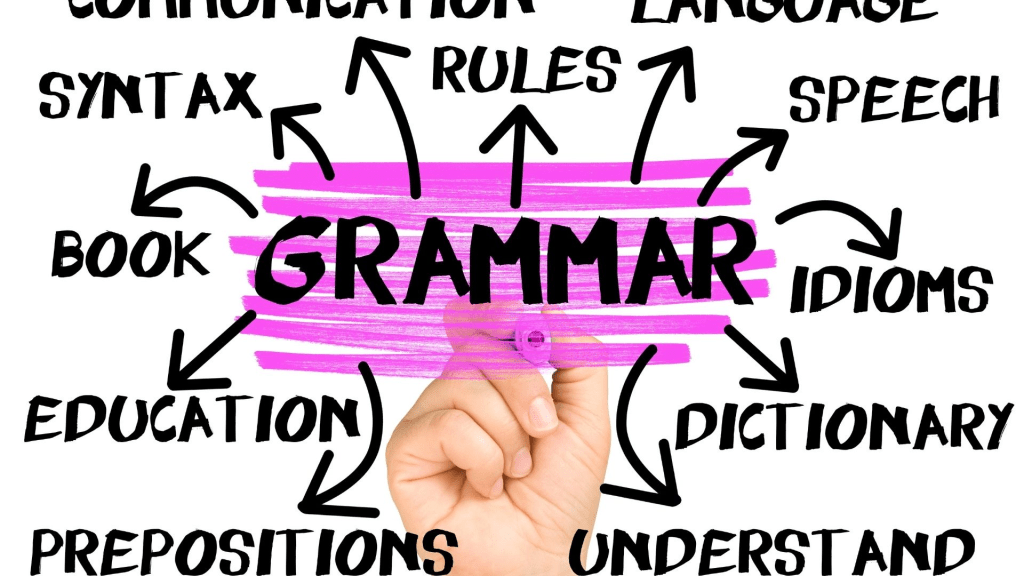Grammar- Grammar refers to the set of rules and conventions that govern the structure and composition of sentences in a language. Proper grammar is essential for clear and effective communication. Here are some key aspects of grammar:
- Parts of Speech: Words in a sentence are categorized into different parts of speech, such as nouns, verbs, adjectives, adverbs, pronouns, prepositions, conjunctions, and interjections. Each part of speech plays a specific role in constructing sentences.
- Sentence Structure: Sentences typically have a subject (who or what the sentence is about) and a predicate (what the subject is doing or what is happening to it). The most basic sentence structure is subject-verb-object (SVO), but there are various other structures depending on the language and context.
- Punctuation: Proper use of punctuation marks, such as periods, commas, semicolons, colons, question marks, exclamation points, and quotation marks, is crucial for indicating sentence boundaries and conveying meaning.
- Tense and Verb Conjugation: Verbs change their form to indicate the time (tense) and subject agreement. Common tenses include past, present, and future. Proper verb conjugation is necessary for accurate communication.
- Agreement: Nouns, pronouns, and verbs must agree in terms of number (singular or plural) and sometimes gender. For example, “He eats” (singular) vs. “They eat” (plural).
- Modifiers: Adjectives and adverbs are used to provide additional information about nouns and verbs, respectively. Proper placement and usage of modifiers help convey precise meaning.
- Syntax: Syntax refers to the arrangement of words and phrases to create well-formed sentences. Word order and sentence structure can vary between languages.
- Concord: Concord, also known as subject-verb agreement, ensures that the verb in a sentence matches the subject in terms of number and person. For example, “She sings” (singular) vs. “They sing” (plural).
- Voice: Verbs can be in active or passive voice, which affects the focus of the sentence. In the active voice, the subject performs the action, while in the passive voice, the subject receives the action.
- Parallelism: Parallel structure involves using consistent grammatical patterns within a sentence or across a series of sentences. This helps maintain clarity and balance in writing.
- Clauses and Phrases: Sentences can contain independent clauses (complete thoughts) and dependent clauses (incomplete thoughts). Clauses can be joined by coordinating conjunctions (e.g., and, but, or) or subordinating conjunctions (e.g., although, because).
- Common Grammar Mistakes: There are many common grammar mistakes, such as using “your” instead of “you’re,” “its” instead of “it’s,” or “their” instead of “they’re.” Proofreading and careful editing can help avoid these errors.
Mastering grammar takes practice and attention to detail. Good grammar enhances your ability to express yourself clearly and effectively in both spoken and written communication.
What is Grammar
Grammar is the set of rules and principles that govern the structure and usage of a language. It encompasses the way words are formed, how they are combined to create sentences, and how those sentences are structured to convey meaning. Grammar provides the framework for clear and effective communication in a given language.
Key aspects of grammar include:
- Parts of Speech: Words are categorized into different parts of speech, such as nouns, verbs, adjectives, adverbs, pronouns, prepositions, conjunctions, and interjections. Each part of speech serves a specific role in constructing sentences.
- Sentence Structure: Sentences are composed of a subject (who or what the sentence is about) and a predicate (what the subject is doing or what is happening to it). Proper sentence structure helps convey meaning clearly.
- Punctuation: Punctuation marks, such as periods, commas, semicolons, colons, question marks, exclamation points, and quotation marks, are used to indicate sentence boundaries and convey nuances in meaning.
- Tense and Verb Conjugation: Verbs change their form to indicate the time (tense) and subject agreement. Proper verb conjugation is essential for expressing actions accurately.
- Agreement: Nouns, pronouns, and verbs must agree in terms of number (singular or plural) and sometimes gender. Ensuring agreement is crucial for grammatical correctness.
- Modifiers: Adjectives and adverbs provide additional information about nouns and verbs, respectively. Proper use of modifiers enhances the specificity and clarity of expressions.
- Syntax: Syntax refers to the arrangement of words and phrases to create well-structured sentences. Different languages have varying syntax rules.
- Voice: Verbs can be in active or passive voice, affecting the focus of the sentence. In active voice, the subject performs the action, while in passive voice, the subject receives the action.
- Concord: Concord, or subject-verb agreement, ensures that the verb in a sentence matches the subject in terms of number and person.
- Parallelism: Parallel structure involves using consistent grammatical patterns within a sentence or across a series of sentences, contributing to clarity and balance in writing.
- Clauses and Phrases: Sentences can contain independent clauses (complete thoughts) and dependent clauses (incomplete thoughts), often linked by conjunctions.
- Common Grammar Mistakes: These are errors frequently made in language usage, such as using “your” instead of “you’re,” “its” instead of “it’s,” or “their” instead of “they’re.” Being aware of common mistakes helps improve grammar.
Correct grammar is crucial for effective communication, as it helps convey ideas accurately and clearly. Different languages have their own grammar rules, and mastering these rules is essential for fluency and proficiency in any language.
Who is Required Grammar
It seems there might be a misunderstanding. “Required Grammar” is not a person or entity; rather, it refers to the necessity of using proper grammar in written and spoken communication. “Required grammar” means that adhering to the rules and conventions of grammar is necessary to convey your message effectively and accurately in a given language.
In any language, proper grammar is important for the following reasons:
- Clarity: Good grammar ensures that your message is clear and easily understood. Proper sentence structure and punctuation help readers or listeners follow your ideas without confusion.
- Accuracy: Correct grammar helps convey your intended meaning accurately. For example, subject-verb agreement ensures that the verb corresponds to the subject in number and person, preventing misunderstandings.
- Credibility: Using proper grammar can enhance your credibility as a communicator. It reflects attention to detail and professionalism, which can be especially important in academic, professional, or formal settings.
- Effective Communication: Whether you’re writing a report, giving a presentation, or having a conversation, adhering to grammar rules helps you express yourself effectively, minimizing the risk of miscommunication.
- Reader or Listener Engagement: Good grammar can make your writing or speech more engaging and enjoyable for your audience. It shows respect for their time and attention.
- Standardization: Grammar provides a standardized set of rules that allows people to communicate consistently within a language community. This standardization is crucial for effective communication on a large scale.
Remember that the specific rules of grammar may vary between languages, and even within the same language, there can be variations in dialects and styles. However, using correct grammar according to the accepted norms of your chosen language is essential for effective communication in that language.
When is Required Grammar

“Required grammar” refers to the necessity of using proper grammar in all forms of written and spoken communication. There are no specific situations or contexts where proper grammar is not important; it is essential in all aspects of language use. Here are some examples of when required grammar applies:
- Academic Writing: In academic papers, essays, and research documents, adhering to proper grammar is crucial to convey ideas accurately and professionally. Academic institutions often have strict grammar and style guidelines.
- Professional Communication: In the workplace, using proper grammar in emails, reports, presentations, and other professional documents is essential for effective communication and maintaining a professional image.
- Job Applications: When applying for jobs, resumes and cover letters should be free of grammatical errors to make a positive impression on potential employers.
- Public Speaking: When giving speeches, presentations, or lectures, proper grammar helps convey information clearly and persuasively.
- Creative Writing: Even in creative writing, where authors may take liberties with language, proper grammar serves as the foundation for effective storytelling and communication.
- Media and Journalism: Journalists and writers in the media industry rely on good grammar to accurately convey news and information to the public.
- Legal and Government Documents: Legal contracts, government regulations, and official documents must use proper grammar to ensure clarity and enforceability.
- Everyday Communication: In everyday conversations, whether with friends, family, or colleagues, proper grammar helps you express yourself clearly and avoid misunderstandings.
- Education: Teachers use proper grammar to instruct students effectively, and students are expected to use it in their assignments and exams.
- Online Communication: In the age of digital communication, emails, text messages, social media posts, and online content should also adhere to proper grammar to maintain professionalism and clarity.
In essence, required grammar is a fundamental aspect of effective communication in almost every aspect of life. It is a skill that should be cultivated and applied consistently to ensure that your messages are understood accurately and that you convey professionalism and credibility in various settings.
Where is Required Grammar
“Required grammar” is not a physical location or a place; it’s a concept related to the necessity of using proper grammar in language and communication. Grammar is not located in a specific physical space but rather exists as a set of rules and principles that govern how language is structured and used.
You can think of grammar as a set of guidelines and conventions that are applied whenever you write, speak, or communicate in a given language. It’s a fundamental aspect of language that applies wherever language is used, whether in spoken conversations, written documents, digital communication, or any other form of human interaction.
So, you won’t find “required grammar” in a particular location, but rather, it’s a fundamental aspect of language that applies wherever language is employed to convey meaning and information. Proper grammar is important in all aspects of life and communication to ensure clarity, accuracy, and effective expression.
How is Required Grammar

“Required grammar” refers to the necessity of using proper grammar in language and communication. The question of “how” to apply required grammar involves understanding and following the rules and conventions of grammar in your spoken and written language. Here are some key principles and guidelines on how to use required grammar effectively:
- Learn the Basics: Start by learning the fundamental rules of grammar, including parts of speech (nouns, verbs, adjectives, etc.), sentence structure, and punctuation. There are many grammar resources and textbooks available for this purpose.
- Proofread and Edit: After writing, take the time to proofread and edit your work. Look for errors in grammar, spelling, punctuation, and sentence structure. Editing helps you catch and correct mistakes.
- Practice Regularly: Improving your grammar skills requires practice. Write regularly, engage in conversation, and seek feedback from others to help you identify and address grammar issues.
- Use Grammar Tools: There are grammar-checking tools and software available that can assist you in identifying and correcting grammar errors. These tools can be helpful, but they should not be relied upon entirely.
- Understand Context: Consider the context in which you are communicating. Different situations may require different levels of formality or specific grammatical constructions.
- Read Widely: Reading books, articles, and other written materials in your language can expose you to correct grammar usage and improve your own language skills.
- Seek Guidance: If you are unsure about a specific grammar rule, consult grammar guides, dictionaries, or seek advice from teachers, tutors, or language experts.
- Listen Actively: In spoken communication, pay attention to how native speakers use grammar. This can help you develop a natural feel for the language.
- Be Mindful of Common Errors: Be aware of common grammar mistakes, such as subject-verb agreement errors, misuse of homophones (words that sound the same but have different meanings), and improper use of punctuation.
- Adapt to Your Audience: Adjust your grammar and style to suit your audience. Formal documents may require more stringent adherence to grammar rules, while casual conversations may allow for more flexibility.
- Stay Informed: Language evolves over time, and grammar rules can change. Stay informed about any updates or shifts in language usage, especially in professional or academic settings.
- Practice Constructive Feedback: When providing feedback to others on their grammar, be constructive and considerate. Correcting grammar mistakes can be helpful, but it should be done in a supportive and respectful manner.
In summary, applying required grammar involves understanding the rules and conventions of grammar in your language, practicing regularly, and being mindful of context and audience. Effective communication relies on proper grammar to convey your ideas accurately and clearly.
Case Study on Grammar
Improving Grammar Skills for Academic Success
Background: Alex is a college student pursuing a degree in English literature. Despite having a strong passion for literature and writing, Alex has been struggling with grammar in academic essays and assignments. This struggle has resulted in lower grades and a lack of confidence in Alex’s writing abilities.
Challenges:
- Frequent errors in subject-verb agreement.
- Difficulty in using complex sentence structures.
- Struggles with punctuation, especially semicolons and colons.
- Limited knowledge of proper comma usage.
- Inconsistent use of tense in essays.
Steps Taken to Address Grammar Issues:
1. Assessment:
- Alex’s professors and academic advisors conducted a comprehensive assessment of Alex’s writing to identify specific grammar weaknesses.
2. Grammar Workshops:
- Alex enrolled in grammar workshops offered by the university’s writing center. These workshops covered topics such as subject-verb agreement, sentence structure, and punctuation.
3. One-on-One Tutoring:
- In addition to workshops, Alex scheduled one-on-one tutoring sessions with a writing tutor. These sessions allowed for personalized feedback and targeted grammar instruction.
4. Grammar Resources:
- Alex used grammar reference books and online resources to reinforce learning outside of class and tutoring sessions.
5. Practice Exercises:
- To improve grammar skills, Alex regularly completed grammar exercises and quizzes from textbooks and online platforms.
6. Peer Review:
- Alex participated in peer review sessions in writing classes. Reviewing peers’ work and receiving feedback helped identify recurring grammar mistakes.
7. Writing Center Visits:
- Alex made use of the university’s writing center for additional support. Writing center staff provided feedback on grammar issues in draft essays.
8. Self-Editing:
- Alex developed a self-editing checklist to review and correct grammar errors before submitting assignments.
9. Consistent Writing Practice:
- Alex committed to writing daily, whether it was journaling, blog posts, or short stories, to reinforce grammar skills.
10. Feedback Loop:
- Alex regularly communicated with professors and tutors to track progress and seek clarification on grammar rules.
Results:
- Over time, Alex’s grammar skills improved significantly.
- The grades on academic essays and assignments began to reflect this improvement, leading to higher overall course grades.
- Alex’s confidence in writing and academic performance increased.
Conclusion: In this case study, Alex’s struggles with grammar in an academic context were addressed through a comprehensive approach that included workshops, tutoring, self-study, and consistent practice. With dedication and support, Alex was able to overcome grammar challenges, leading to improved academic success and greater confidence in writing abilities. This case study highlights the importance of identifying and addressing grammar issues early to achieve academic and personal goals.
White paper on Grammar

The Foundations of Effective Communication
Executive Summary
Grammar is the fundamental framework of language, serving as the bedrock upon which effective communication is built. In this white paper, we explore the importance of grammar, its role in various aspects of communication, and its significance in academic, professional, and everyday contexts. We also discuss the challenges associated with grammar in the digital age and provide recommendations for enhancing grammar skills.
Table of Contents
- Introduction
- Defining Grammar
- Importance of Grammar
- The Role of Grammar in Communication
- Clarity and Precision
- Conveying Intent
- Professionalism and Credibility
- Standardization and Consistency
- Grammar in Academic Settings
- Essays and Research Papers
- Academic Success and Grammar Proficiency
- Grammar in Professional Communication
- Workplace Emails and Documents
- Business Presentations
- Job Applications and Resumes
- Everyday Communication
- Conversations and Social Interactions
- Digital Communication
- Social Media and Informal Writing
- Challenges in Grammar
- Common Grammar Mistakes
- The Impact of Technology
- Language Evolution
- Improving Grammar Skills
- Grammar Workshops and Courses
- Online Resources and Tools
- Writing Practice
- Peer Review and Feedback
- The Role of Technology
- Conclusion
- The Ongoing Relevance of Grammar
- Empowering Effective Communication
1. Introduction
Defining Grammar: Grammar is the set of rules and principles that govern the structure, composition, and usage of language. It encompasses the way words are formed, how they are combined to create sentences, and how those sentences are structured to convey meaning.
Importance of Grammar: Proper grammar is essential for effective communication in any language. It enables individuals to express themselves clearly, accurately, and professionally, regardless of the context. Without grammar, language would lack structure and coherence, making communication challenging or even impossible.
2. The Role of Grammar in Communication
Clarity and Precision: Grammar ensures that messages are conveyed clearly and without ambiguity. Proper sentence structure and punctuation aid in the precise expression of ideas.
Conveying Intent: Grammar helps individuals convey their intended meaning accurately, preventing misunderstandings and misinterpretations.
Professionalism and Credibility: In professional and academic settings, adhering to proper grammar enhances professionalism and credibility. It reflects attention to detail and respect for the audience.
Standardization and Consistency: Grammar provides a standardized set of rules that allow people to communicate consistently within a language community. This standardization is crucial for effective communication on a large scale.
3. Grammar in Academic Settings
Essays and Research Papers: Academic success is closely tied to grammar proficiency. Essays, research papers, and assignments require precise grammar to convey complex ideas.
Academic Success and Grammar Proficiency: Grammar skills are often a determinant of academic success. Proficiency in grammar enables students to excel in their coursework and effectively communicate their research findings.
4. Grammar in Professional Communication
Workplace Emails and Documents: Proper grammar is essential in workplace emails, reports, and other documents. It helps maintain professionalism and ensures that information is communicated accurately.
Business Presentations: When delivering business presentations, grammar plays a crucial role in conveying information persuasively and maintaining the audience’s attention.
Job Applications and Resumes: Job seekers must use proper grammar in resumes and cover letters to create a positive impression on potential employers.
5. Everyday Communication
Conversations and Social Interactions: Whether in casual conversations with friends or important discussions with family, using proper grammar enhances clarity and effective communication.
Digital Communication: In the digital age, grammar is vital for emails, text messages, and other forms of digital communication.
Social Media and Informal Writing: Even in informal settings such as social media, proper grammar can enhance the quality of communication and convey messages more effectively.
6. Challenges in Grammar
Common Grammar Mistakes: Many individuals struggle with common grammar mistakes, such as subject-verb agreement errors, misuse of homophones, and improper punctuation.
The Impact of Technology: While technology has provided tools for grammar correction, it has also contributed to a decline in grammar proficiency as people rely more on automated checks.
Language Evolution: Languages are constantly evolving, and some traditional grammar rules may change over time. Staying informed about language shifts is essential.
7. Improving Grammar Skills
Grammar Workshops and Courses: Enrolling in grammar workshops or courses can provide structured learning opportunities.
Online Resources and Tools: There are various online resources, grammar-checking tools, and grammar apps available for self-study and improvement.
Writing Practice: Regular writing practice, such as journaling, blogging, or creative writing, can reinforce grammar skills.
Peer Review and Feedback: Engaging in peer review and seeking feedback from others can help identify and address grammar issues.
The Role of Technology: While technology can contribute to grammar challenges, it can also be used to enhance grammar skills through interactive learning apps and platforms.
8. Conclusion
The Ongoing Relevance of Grammar: Despite advances in technology and changes in language usage, grammar remains a critical component of effective communication. It continues to be a cornerstone of language and a skill worth cultivating.
Empowering Effective Communication: By prioritizing grammar proficiency in academic, professional, and everyday communication, individuals can empower themselves to communicate with clarity, precision, and credibility, ultimately leading to successful and meaningful interactions.
In conclusion, grammar is the foundation of effective communication in all aspects of life. It shapes the way we express ideas, convey information, and connect with others. Embracing proper grammar is a commitment to clear, accurate, and impactful communication, making it an essential skill for individuals across various walks of life.





